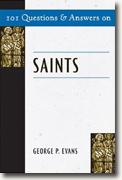101 Questions & Answers on Saints
George P. Evans
book reviews:
· general fiction
· chick lit/romance
· sci-fi/fantasy
· graphic novels
· nonfiction
· audio books
· author interviews
· children's books @
curledupkids.com
· DVD reviews @
curledupdvd.com
newsletter
win books
buy online
links
home
for authors
& publishers
for reviewers

 |
101 Questions & Answers on Saints George P. Evans Paulist Press Paperback 146 pages March 2007 |
|
I read 101 Questions & Answers on Saints
“Saint” comes from the Latin word sanctus, which means holy. A saint is holy and resides with God in heaven. Evans discusses the place Mary holds in the realm of saints as well as other introductory issues such as All Saints’ Day and Halloween. In his discussion of how saints have been honored over time, Evans touches on the notion of patronage and how it developed over time. He also discusses the criticism that Martin Luther levied against devotion to saints. Concerning the history of the canonization process, Evans notes that the pope did not always canonize saints but became the ultimate decider as time progressed. He examines the process and different levels involved in a canonization cause, and he also presents how the Orthodox Churches canonize saints. Deciding martyrdom was not always as difficult as it is in contemporary times. Are Archbishop Oscar Romero of San Salvador, El Salvador, the four Americans murdered in El Salvador, and others truly martyrs, or were they killed for solely political reasons? Pope Benedict’s comments at a recent talk he gave at the March 25, 2007 Angelus suggest that Romero is a martyr, else he probably would not have been mentioned at all. That is why the canonization process, as Evans shows, is needed: to make sure that a charlatan is not erroneously canonized. Over time, religious biographies have changed in style and expectations. In Evans discussion on hagiography, he mentions the recent interest in St. Mary Magdalene and her biography. Exactly what place do the saints hold in the Liturgy or prayer of the Church? The ranking of saints’ days have changed over time. Before Vatican II (1962-1965), the liturgical calendar was full of saints’ days, which interfered with the keeping of the cycle of events of the mysteries of salvation. The reforms of Vatican II in the liturgy emphasized the mysteries of salvation over honoring the saints. To achieve this, many saint’s feast days were moved from the days of Lent to other days. One example is the feast of St. Gregory the Great. His feast day - originally March 12th, the day he died in 604 - was moved to September 3rd, which happens to be the day he was elected pope. Fr. Evans also examines the hows and whys of saint’s day distribution in the calendar. Images of saints have been made as icons, statues, portraits, and as components of other art pieces; Evans also discusses the superstition of burying a statue of St. Joseph to sell a home. Fr. Evans covers the tradition of giving a saint’s name to a child at baptism and taking another saint’s name at confirmation. He talks about religious taking new names, too, when they enter their orders. He discusse what relics and reliquaries are, and he also talks about the phenomenon of bodies being incorruptible. The book closes with endnotes. Saints are fascinating to many, though a significant number of people do not have a clear understanding of what saints are. Most people are familiar with Mother Teresa of Calcutta; many considered her a living saint. In determining sainthood, the Catholic Church is concerned only about deceased candidates. Miracles attributed to persons during their lives do not help to promote the cause of that person. The Catholic Church looks at miracles attributed to persons that have occurred after their deaths. Mother Teresa and Pope John Paul II’s causes are only advancing now because they have interceded for people with a miracle. This book is recommended to those interested in saints and the process of making them known to the world and to those interested in the Catholic Church and saints. This book is an excellent tool for RCIA programs or those learning about the Catholic Church. Originally published on Curled Up With A Good Book at www.curledup.com. © Br. Benet Exton, O.S.B., 2007 |
|
|
|
 Click here to learn more about this month's sponsor! |
|
| fiction · sf/f · comic books · nonfiction · audio newsletter · free book contest · buy books online review index · links · · authors & publishers reviewers |
|
| site by ELBO Computing Resources, Inc. | |
 The book is divided into eight parts: the basics - Saints 101; honoring the saints, past and present; canonization of saints; martyrdom; hagiography, or the life stories of the saints; the saints in liturgy; the saints in art; and saints’ names and remains. Fr. Evans gives an overview about whom and what saints are, discussing what Catholics mean by “saint” and how that differs from what Protestants and others mean by the term. The Orthodox definition is the same as the Catholic, but the two go about making known who saints are differently.
The book is divided into eight parts: the basics - Saints 101; honoring the saints, past and present; canonization of saints; martyrdom; hagiography, or the life stories of the saints; the saints in liturgy; the saints in art; and saints’ names and remains. Fr. Evans gives an overview about whom and what saints are, discussing what Catholics mean by “saint” and how that differs from what Protestants and others mean by the term. The Orthodox definition is the same as the Catholic, but the two go about making known who saints are differently.